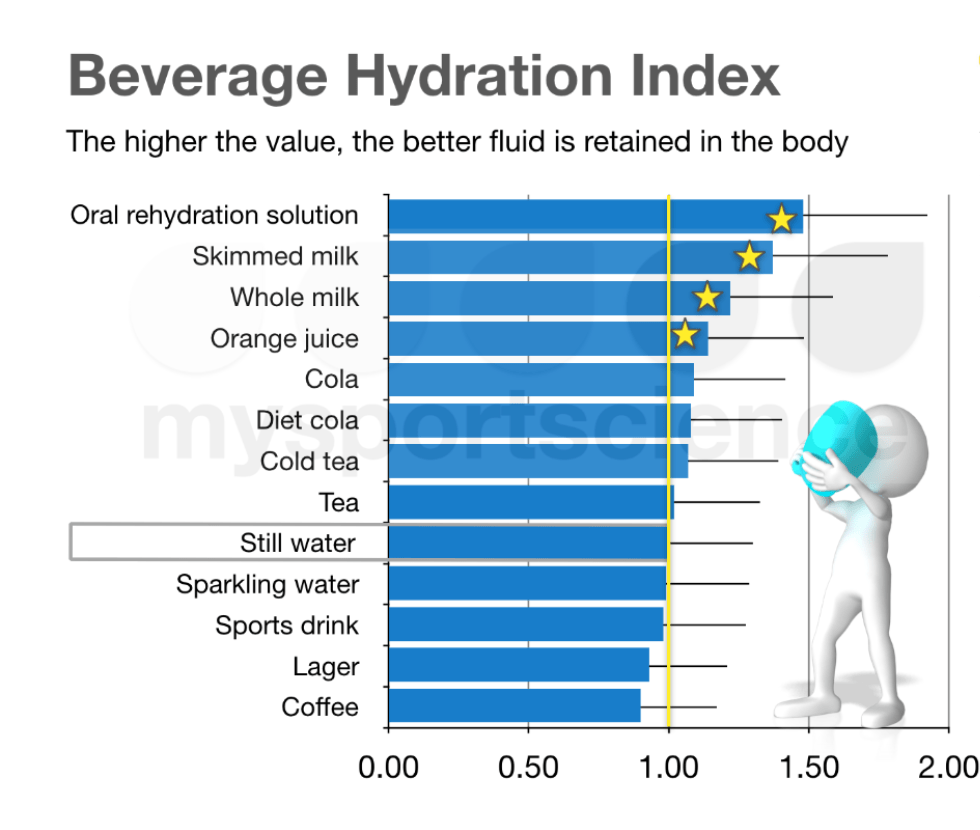Table of Contents
- Relationship between dehydration and fatigue
- Sweat rate
- How much and when to drink
- Types of drinks and hydrating properties
- Myth busting
- Bibliography
Relationship between dehydration and fatigue
In cycling, fatigue can be caused by many factors such as: psychological factors, internal temperature, depletion of energy substrates, peripheral factors or nervous system fatigue. All these factors contribute to a greater or lesser extent to fatigue and to the subsequent stoppage of the exercise. Each of them will be the limiting factor and, therefore, the most important to take into account in different situations experienced during the exercise. For example, during a marathon at 30ºC, the internal temperature and the depletion of energy substrates will be key to determine the fatigue of a runner. Well, in this article we will talk about hydration in cycling, another key factor contributing to fatigue that can lead to significant losses in cycling performance, especially in long and hot situations.
The dehydration status is usually calculated as a % weight loss in relation to body weight, in the form of water through sweat. Based on this percentage, the severity of dehydration can be calculated, considering a mild dehydration of less than 5%, moderate between 5 and 10% and severe one from 10%. Under normal conditions, the 5% dehydration mark should not be exceeded for health reasons and in the case of physical and cognitive performance, detriments are already experienced in lower loss ranges.
In relation to performance, both cognitive and physical, losses are observed at 1-2% of dehydration [1]. If we take into account that the feeling of thirst occurs after 2%, waiting for the feeling of thirst to drink would be too late to obtain optimal performance. These detrimental effects in relation to performance are present in all endurance sports and are caused by the loss of blood volume and its consequent decrease in cardiac output. In strength or power sports, no specific threshold has been detected from which performance worsens nor the mechanisms through which it happens, but changes have been observed that, although small, might be relevant. The same happens with cognitive performance, in which slight changes are observed in relation to performance with dehydration, which are caused by greater distraction or discomfort [2].
Muscle cramps
A problem commonly found in cyclists and other endurance athletes is the appearance of ramps. Among the risk factors for cramps, we find: exercise intensity, lack of conditioning, muscle fatigue, heat, electrolyte balance and dehydration. Many times, the cyclists who sweat more and who lose more salt in their sweat (salty sweaters) are the ones who are more likely to experience cramps, since they finish more dehydrated [3].
As previously seen, in order to have optimal performance and reduce the probability of suffering cramps, it is recommended to limit the fluids loss through sweating to around 1-2% of body weight. But for this, we must first know how much we sweat in a set time (sweat rate), in order to know how much we should drink to perform optimally.
Sweat rate
The sweat rate is the amount of fluid we lose each hour through sweat while we exercise. This rate presents great interpersonal variability as can be seen in the graph below with people who can sweat 0.5L/h and another 2L/h under the same conditions, hence the importance of individualizing in each case. There is also great variability in the sodium concentration in sweat with values from 20mmol/L to 90mmol/L. Therefore, we have four groups of people: big salty sweaters, big unsalty sweaters, little salty sweaters and little unsalty sweaters.

These sweating values also vary depending on: temperature, humidity, intensity of exercise, degree of adaptation to heat, wind speed, clothing and genetics. Because of that, it would also be interesting to have two or three records of sweating rates in different conditions for each cyclist, especially in different conditions of temperature and humidity, which are the most relevant factors, in order to adjust perfectly in each case.
How to calculate the sweat rate
To calculate the sweating rate, we will carry out a short training session of about an hour or an hour and a half in which we will look at the variation in the cyclist’s weight, also taking into account the amount of liquid ingested during the training session.
Thus, we weigh the cyclist before (C1) and post (C2) training without any clothes on, having dried itself properly in the post-training weigh-in with a towel, to remove any sweat that may be accumulated on the skin and hair. We also weigh the water bottles pre (B1) and post (B2) training, to know the amount of liquid ingested and take it into account. In addition to the pre and post mass measurements, we will also need the total training time (H) and the training conditions (temperature, humidity, time and type of training). The training conditions will help us to put each sweat rate in context and know how it varies in different conditions. The calculation that must be carried out once the test is done to know the sweating rate is the following: sweating rate = ((C1-C2) +(B1-B2))/H. In summary, we add the pre-training weights and to these we subtract the post-training weights, once done we divide it by the total hours of training.
How to use the sweat rate
Once we have the result of the test, we can adjust the amounts that a specific cyclist has to drink to perform optimally. Let’s take an example of a 70kg cyclist who has a sweat rate of 1L/h. For this cyclist in a 4h competition and adjusting the fluid loss to 2% to limit performance losses we would obtain the following:
- 2% of 70kg is 1.4kg. This is the amount we will calculate that he would have to lose at the end of the race.
- By sweating 1L/h for 4h he will sweat a total of 4L which is equivalent to 4kg.
- If we subtract from these 4L the 1.4 that we have calculated he is going to lose, we find that he has to drink about 2.6L during the competition. This divided by the 4h, comes out to 0.65L/h ingested. Or a bit more than a small water bottle per hour.
If this cyclist drinks less than 0.65L/h or forgets to drink during the first hour, he will arrive at the end of the competition with greater dehydration than desired, which will be detrimental to his performance.
How much and when to drink
In the competition day it is important to start with an optimal state of hydration. It is advisable to drink 0.5L the 2 hours prior to the competition.
During the competition, you should drink frequently in small sips, reaching the optimal amounts previously estimated for each case. You should not wait until you feel thirsty, since the sensation of thirst usually appears when you pass the 2% dehydration mark, therefore, you would already be going late since 2% dehydration entails a considerable loss of performance.
After the competition, it is usually recommended to ingest 1.5 times the amount of fluid lost during the 2-5 hours that follow. Taking into account the example given before, this would be equivalent to ingesting 1.4L x 1.5 = 2.1L during the 2-5 hours after the competition.
As a last measure to consider regarding when to drink, it is convenient to limit the amount of drink in the last hours of the day since it can influence the quality of sleep, making you wake up to urinate.
Types of drinks and hydrating properties
Once we are clear about how much and when to drink, we move on to see what to drink. Depending on the type of drink, different hydration index can be observed. Compared to natural water, there are some drinks that have a greater amount of liquid retention and therefore a greater hydration capacity. According to Maughan these are in this order: oral rehydration solution, skimmed milk, whole milk and orange juice. Other drinks with a slightly higher hydration index than water, although not significant, are Coca-Cola and iced tea. Lastly, drinks such as sparkling water, isotonic sports drinks, beer or coffee present hydration indices similar to water, with beer and coffee being the worst, although with no significant differences [5].

Myth busting
Does coffee dehydrate?
It has been observed that caffeine has diuretic properties i.e., it increases the elimination of liquids. This, however, occurs with amounts of caffeine of about 500mg [6]. Taking into account that a normal coffee contains about 80mg of caffeine, to reach these 500mg we would have to consume about 6 coffees. In addition, a tolerance to this diuretic effect develops in regular coffee consumers. In a race, about 3-4mg/kg of caffeine is usually recommended to obtain the maximum benefits. For our 70kg cyclist, this would equate to 210-280mg, a far cry from 500mg. Therefore, in normal doses, coffee does not dehydrate.
Should we take sodium with our drink or salt pills?
According to Asker Jeukendrup:
“Sodium does not help water absorption from drinks in any major way (glucose is much more important for this). However, sodium will make a drink taste better and make you thirstier. Therefore, you are more likely to drink and this will of course help you to stay hydrated (but you probably don’t need salt tablets for this and just adding small amounts of sodium to a drink may be more effective)” [7].
Sodium intake during competitions will be especially important during events of long duration >4h in which there is high fluid replacement and/or in hot conditions where there are high sodium losses through sweat.
Has beer better hydrating properties than water?
As mentioned in a previous section, beer has an hydrating capacity similar to water, and in the case of beers with a stronger alcohol content, this seems to be somewhat lower. For that reason, no. Beer is no better than water for hydration after exercise. Although soft or non-alcoholic beers have a similar capacity to water.
Bibliography
[1] Hillyer, M. et al. (2015). The Effects of Dehydration on Skill-Based Performance. International Journal of Sports Science.
[2] Cheuvront, S. & Kenefick, R. (2014). Dehydration: Physiology, Assessment, and Performance Effects. Comprehensive Physiology.
[3] Maughan, R. & Shirreffs, S. (2019). Muscle Cramping During Exercise: Causes, Solutions, and Questions Remaining. Sports Medicine.
[4] Barnes, K. (2019). Normative data for sweating rate, sweat sodium concentration, and sweat sodium loss in athletes: An update and analysis by sport. Journal of sports sciences.
[5] Maughan, R. et al. (2015). A randomized trial to assess the potential of different beverages to affect hydration status: development of a beverage hydration index. The American Journal of Clinical Nutrition.
[6] Killer, S. (2014). No Evidence of Dehydration with Moderate Daily Coffee Intake: A Counterbalanced Cross-Over Study in a Free-Living Population. PLOS ONE.
[7] Jeukendrup, A. The role of sodium during exercise. https://www.mysportscience.com/post/the-role-of-sodium-during-exercise.



